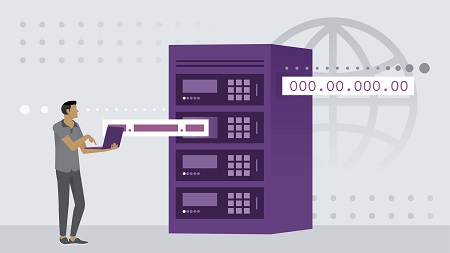
English | MP4 | AVC 1280×720 | AAC 48KHz 2ch | 2h 35m | 311 MB
Dynamic Host Configuration Protocol (DHCP) is the system that automatically assigns IP addresses to hosts, and Domain Name System (DNS) resolves fully qualified domain names to IP addresses. If you’re a network administrator charged with managing a Microsoft network environment, then it’s essential that you have a solid understanding of both of these networking services. In this course, Ed Liberman dives into DHCP and DNS, explaining how they work in the context of a Windows Server 2019 environment. Learn how to install, configure, and manage a DHCP server, as well as how to deploy DNS. Plus, explore name resolution in enterprise networks, including how to configure standard and conditional DNS forwarding.
Topics include:
- What is Dynamic Host Configuration Protocol (DHCP)?
- Setting up DHCP
- Securing and troubleshooting DHCP
- Configuring a DHCP relay agent
- Deploying Domain Name System (DNS)
- Creating stub zones and reverse lookup zones
- Testing queries
- DNS security
Table of Contents
Introduction
1 DHCP and DNS in WIndows Server E9
2 Course organization
Dynamic Host Configuration Protocol (DHCP) Overview
3 What is DHCP
4 Lease generation
5 Lease renewal
Setting Up DHCP
6 Install the DHCP server role
7 Authorize a DHCP server
8 Create DHCP scopes
9 Configure DHCP options
10 Activate a scope
11 Configure DHCP clients
12 Configure DHCP reservations
Managing DHCP
13 Components of a DHCP database
14 Reconcile DHCP scopes
15 Database statistics
16 Secure DHCP
17 Troubleshoot DHCP
DHCP Advanced Features
18 Configure DHCP failover
19 Manage DHCP failover
20 DHCP in a routed environment
21 Configure a DHCP relay agent
22 Test relay agent
Deploying DNS (Domain Name System)
23 Install DNS with Active Directory
24 Install the DNS role independently
25 DNS client configuration
DNS Zones
26 Create primary forward lookup zones
27 Configure zone transfers
28 Create secondary forward lookup zones
29 Create stub zones
30 Active Directoryintegrated zones
31 Create reverse lookup zones
DNS Resource Record Types
32 Host and pointer (PTR) records
33 Alias (CNAME) record
34 Mail exchanger (MX) record
35 Additional resource record types
Name Resoution
36 DNS queries
37 Testing queries
38 DNS cache
39 Forwarding
40 Conditional forwarding
41 Caching only DNS servers
DNS Security
42 DNS cache locking
43 DNS socket pool
44 DNS security extensions
Conclusion
45 Next steps
Resolve the captcha to access the links!